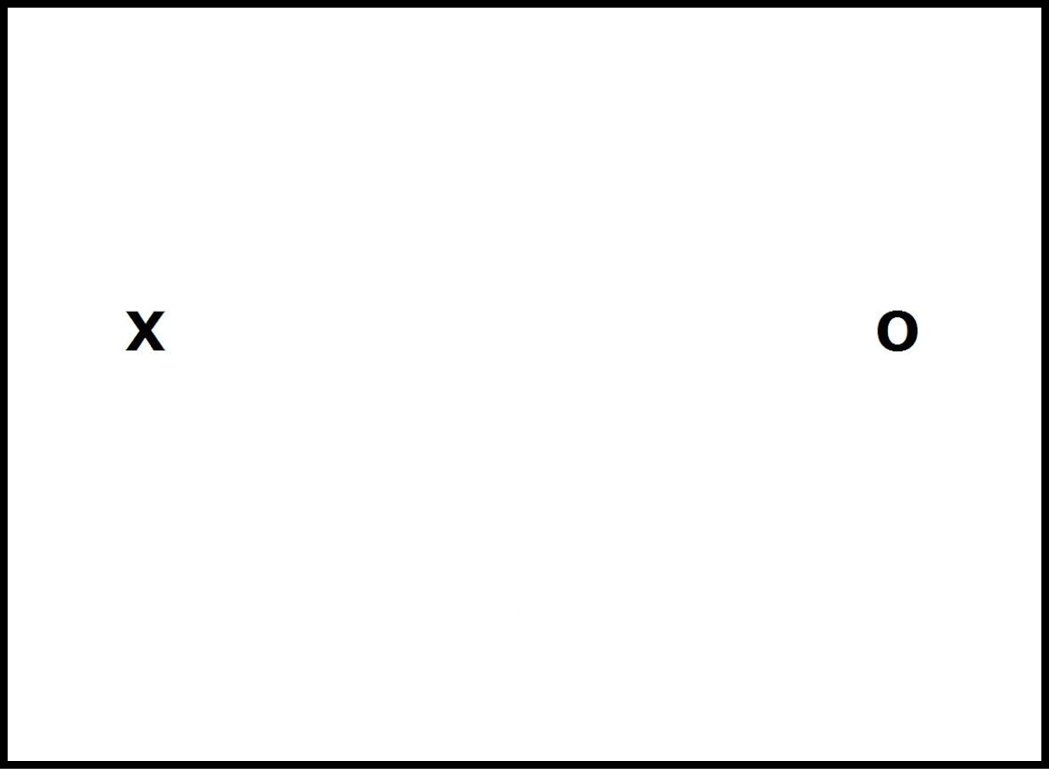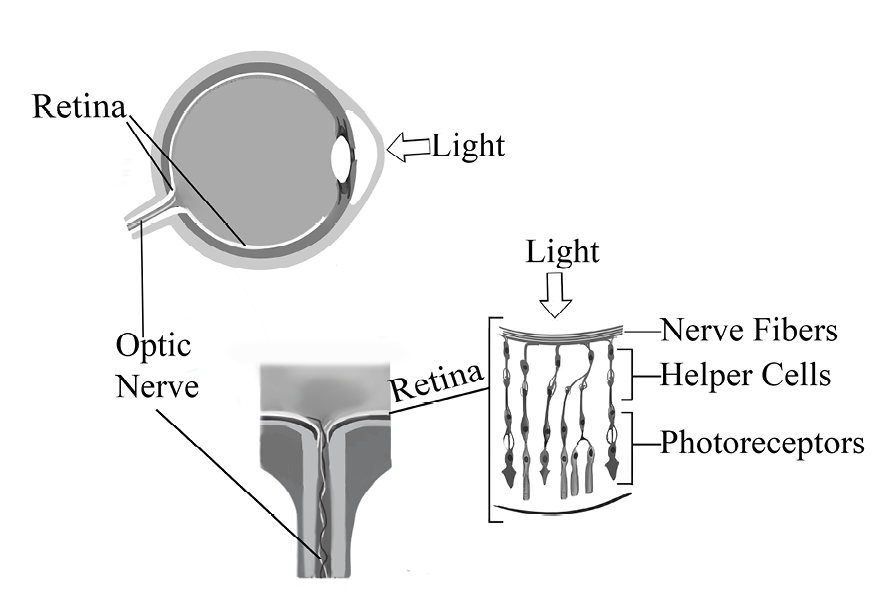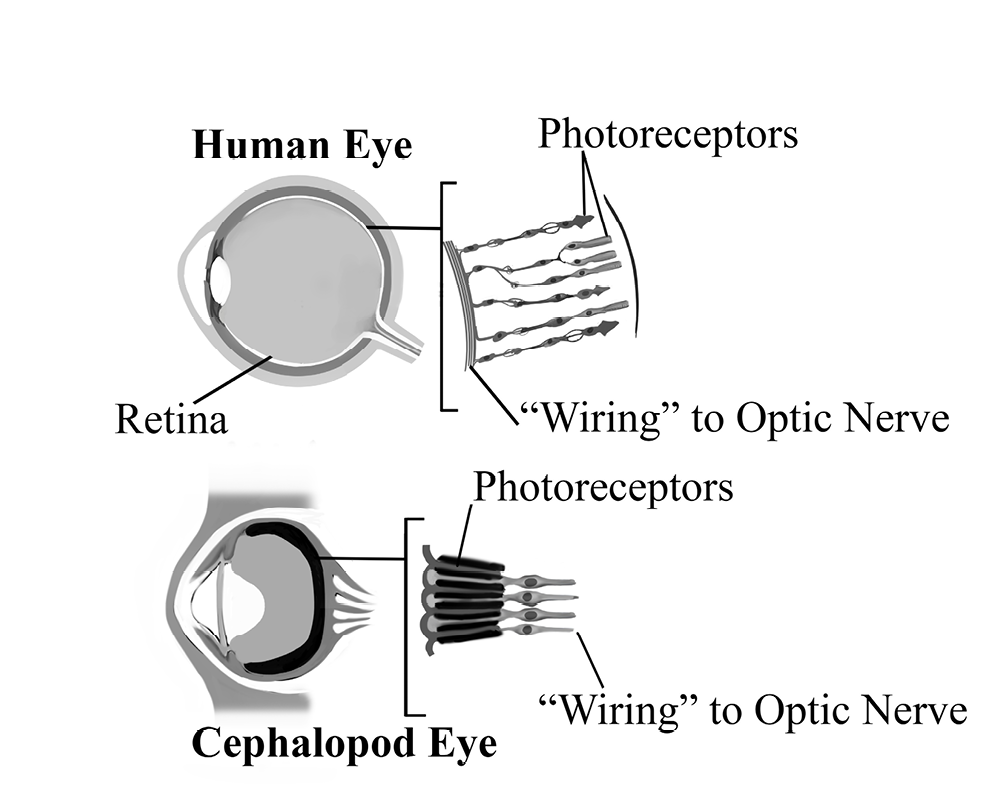Chapter 22
Bad Design—the Human Eye
Here’s why our eyes are a case of bad design.
Try to imagine a camera so poorly designed that the mechanical parts of the camera—the wires and so on—were between the lens and the imaging chip, so they left their shadows on all your pictures. Then imagine having to photoshop those shadows out of every one of your pictures in order to have usable images. Imagine further that all of the wires are routed through a hole in the imaging chip to the back of the camera, so that there is a permanent hole in the chip where there can be no image at all. This is the case with our eyes. This is bad design.
The part of our eye that is sensitive to light, the part that is like the imaging chip in a camera, is our retina.
The first bit of bad design in our retina is that there are blood vessels sitting on the surface of the retina, blocking the light. A decent designer could have put those blood vessels behind the retina.
The second bit of bad design is that there are nerve fibers that also sit on the surface of the retina, blocking even more light. These, too, could have been placed behind the retina, if anyone had been trying to design the eye properly. Unfortunately, no one was.
The third bit of bad design is that these blood vessels and nerve fibers all meet in one spot and go straight through the retina and into the optic nerve. This is like punching a hole in the imaging chip of a camera. It creates a part of our retina that is so clogged with all this paraphernalia that it cannot see at all. This is known as the blind spot, or optic disc. If all these blood vessels and nerve fibers had been properly placed behind the retina in the first place, then this hole in our vision would not exist. Putting preventable blind spots into a visual system is not the sign of an infallible Creator.

Figure 22.1 Find your blind spot.
Here is my proof, in case you need it. You can find your own blind spot. Just use the figure above, and follow these directions:
Hold the test about eighteen inches from your face. Close your left eye while focusing your right eye on the X. The X should be placed directly in front of your right eye. Move the test slowly toward your face, and keep your right eye trained on the X. When the O located to the right of the X goes away, you have found your blind spot.
So now that you can find your blind spot, let me show you pictures of why it exists. Here is a picture of your retina taken with an ophthalmoscope, showing the blood vessels lying on top of the retina.

Figure 22.2 Photograph of the human retina, taken with an ophthalmoscope.
Notice the blood vessels lying on top of the retina, which block the path of the light that’s traveling to the photoreceptors.

And here is the diagram of your retina, showing the nerves lying on
Figure 22.3 Diagram of the human retina and optic nerve.
Notice the blood vessels, nerve fibers, and many layers of cells that are blocking the path of the light that’s going to the photoreceptors. The nerve fibers and blood vessels on top of the retina converge before entering the optic nerve, blocking the light entirely. This forms the human eye’s blind spot.
top of the retina and blocking the light that should be going to the photoreceptors underneath. This also shows the blood vessels and nerve fibers diving through the retina to get to the optic nerve.
What all this means is that we need more light to see with than we would if our eyes had been designed properly. It also means that your nervous system receives poor quality visual information that then has to be processed several times before the information becomes a good image. If this were a camera, this would mean exposing multiple pictures with all the shadows from the wires on it and the hole going right through it, loading all the lousy pictures onto a computer, removing the shadows of the wires from each one, and combining several until you got one usable image that more or less represents reality. Even then, some information has been lost. This is a cumbersome, imperfect process for a supposedly infallible Creator to have come up with.
One would think that God could do better.

Figure 22.4 Cuttlefish.
And God did.
This is a picture of God’s favorite. It’s a cuttlefish. It and its relatives, squid and octopi, have eyes with retinas that are built far better than ours. They see better, and in dimmer light than we do. They can also recognize polarized light, a useful ability that we don’t have at all.
So—does the Designer like cuttlefish better than humans?
Now take a look at that beautiful eye, so much like ours, but wired so much better, and then look at these drawings.

Figure 22.5 Diagrams of human and cephalopod eyes.
These are diagrams of the human eye and the cephalopod eye. Cephalopods do not have backbones and include squid, octopi, and cuttlefish. Notice how the “wiring” that takes the visual information from the photoreceptors to the optic nerve is located behind the photoreceptors in cephalopods, but between the photoreceptors and the light in humans. As I said earlier, this is like having the wiring for a camera placed between the lens and the imaging chip. It makes no sense if our eyes had been designed, but from an evolutionary standpoint it makes sense, because it works well enough and does us more good than harm.
However, I should point out that the standards for evolved features can go even lower than that. Sometimes they don’t even meet the criterion that they do more good than harm. Sometimes the only standard that they meet is that they don’t kill us before we reproduce . . . too often.